#designautomation
Explore tagged Tumblr posts
Text
The PCB Design Software Market: Transforming Product Development Across Industries
The global PCB Design Software market is poised for significant growth, reaching $7,939 million by 2030, driven by rising demand in industries like telecommunications, automotive, and IoT. PCB Design Software helps companies streamline product development, reduce costs, and improve performance across various sectors. With advancements in schematic capture and cloud-based solutions, PCB design tools are more accessible and powerful than ever.
#pcbdesign#electronics#iot#automotive#telecom#cloudcomputing#radarsystems#pcbsoftware#engineering#innovation#productdesign#digitaltransformation#cad#designautomation
2 notes
·
View notes
Text
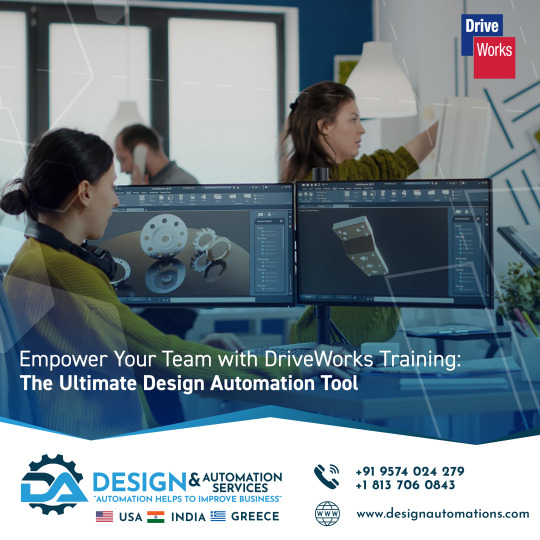
Unlock your team's potential with Design and Automation Services' comprehensive DriveWorks Training. 🚀 Master design automation to streamline your processes, eliminate errors, and accelerate custom product delivery. 📈
Our expert-led courses offer hands-on experience, equipping your staff with the skills to leverage DriveWorks for optimal efficiency and innovation. 💡
Start transforming your workflow today - enroll in DriveWorks Training with Design and Automation Services now and take your design capabilities to the next level! 🌟 Call us on 📞 +91 9574 024 279 or Visit: https://www.designautomations.com/
#DesignAndAutomationServices#DriveWorks#DriveWorksTraining#DesignAutomation#StreamlineProcesses#EliminateErrors#CustomProductDelivery#HandsOnExperience#EfficiencyAndInnovation#TransformYourWorkflow#MasterDriveWorks
2 notes
·
View notes
Text
AutoCAD Electrical Training: Boost Your Control Design Skills
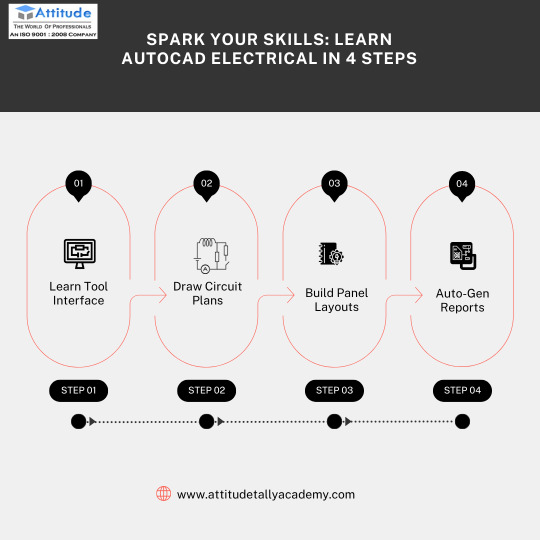
This infographic delivers a focused overview of AutoCAD Electrical training, ideal for electrical engineers, designers, and automation professionals. It covers essential features such as schematic design, panel layout, symbol libraries, wire numbering, and real-time error checking. A must-have visual guide for anyone looking to improve their electrical control system designs using AutoCAD Electrical.
Visit Attitude Academy
Yamuna Vihar :- https://maps.app.goo.gl/gw9oKCnXDXjcz4hF7
Uttam Nagar :- https://maps.app.goo.gl/iZoQT5zE3MYEyRmQ7 .
Yamuna Vihar :+91 9654382235 || Uttam Nagar :+91 9205122267
Visit Website: https://www.attitudetallyacademy.com
Email: [email protected]
#AutoCADElectrical#ElectricalDesign#CADTraining#ControlSystems#ElectricalEngineering#PanelLayout#WiringDiagrams#AutomationDesign#SchematicDesign#DesignAutomation#AutoCADTips#CircuitDesign
1 note
·
View note
Text
Smarter VLSI Design Through AI-Powered Innovation
As semiconductor technology continues to evolve, the demand for high-performance and energy-efficient chips is reshaping how integrated circuits are designed. Traditional VLSI (Very-Large-Scale Integration) methods, while foundational, are becoming insufficient for the scale and complexity of modern electronics. To bridge this gap, Artificial Intelligence (AI) is being integrated into VLSI design workflows — unlocking smarter, faster, and more optimized chip development.
Tech4BizSolutions is actively leveraging AI to enhance every stage of the VLSI lifecycle, from architecture planning to post-silicon validation.

What Is AI-Driven VLSI Design?
AI-driven VLSI design refers to the application of machine learning, deep learning, and data analytics to automate and optimize various stages of chip design and manufacturing. Unlike conventional design flows, AI can identify patterns, predict outcomes, and generate insights from massive datasets in real-time.
Key advantages include:
Improved performance-to-power ratio
Reduced manual effort in layout planning
Faster design rule checking and validation
Enhanced yield prediction and fault analysis
Tech4BizSolutions integrates AI across multiple design layers, reducing time-to-market while improving design accuracy and production reliability.
How Tech4BizSolutions Enhances VLSI with AI
At Tech4BizSolutions, we fuse our deep domain knowledge in semiconductor design with cutting-edge AI techniques. Here’s a breakdown of how we apply AI to make VLSI smarter:
1. AI in Design Space Exploration
Design space exploration is one of the most time-consuming phases of VLSI. Our AI models intelligently evaluate thousands of possible configurations, identifying the most efficient architecture with minimal resource usage.
Tech4BizSolutions Result: Up to 50% reduction in time spent exploring design alternatives.
2. Automated Floorplanning and Layout Optimization
Floorplanning and placement affect timing, area, and power consumption. We use neural networks to predict optimal component placement and signal routing paths, reducing congestion and delay.
Tech4BizSolutions Advantage: Increased chip efficiency with reduced layout iterations.
3. AI-Enhanced Timing and Power Analysis
Tech4BizSolutions uses AI models trained on historical data to predict timing violations and power bottlenecks before physical implementation. This allows early-stage corrections, saving time and silicon costs.
Outcome: More accurate PPA (Performance, Power, Area) metrics at the RTL level.
4. Fault Detection and Yield Improvement
AI helps detect subtle, non-obvious design flaws by recognizing patterns in simulation and test bench outputs. We also use AI to simulate rare corner cases that are typically missed in standard verification cycles.
Business Impact: Higher first-pass silicon success rates and lower manufacturing risks.
5. Adaptive Learning Systems for Continuous Optimization
Our AI systems are not static. They learn and evolve with every project. We build feedback loops where post-silicon data refines future simulations and models — creating a smarter design pipeline over time.
Long-term Benefit: Each new chip design becomes more efficient than the last, reducing NRE (Non-Recurring Engineering) costs.
Tech4BizSolutions: Delivering Tangible Business Value
By embedding AI into VLSI design workflows, Tech4BizSolutions helps clients:
Speed up development cycles by up to 40%
Reduce power consumption by designing for energy-aware applications
Increase IC performance through AI-informed microarchitecture tuning
Minimize silicon iterations and time spent on debugging
Predict and eliminate faults before tape-out
This makes our approach ideal for industries like:
Consumer Electronics
Automotive & EV
Industrial Automation
Telecom and 5G
IoT and Edge Devices
Real-World Use Case
Let’s say a client needs a custom AI accelerator chip for real-time video processing. With traditional VLSI design, modeling workloads, optimizing for latency, and reducing power draw can take months.
With Tech4BizSolutions’ AI-enhanced VLSI flow, we:
Use AI models to simulate expected video processing loads
Automatically adjust component placement for thermal efficiency
Predict the power envelope across real-world scenarios
Validate logic paths using AI-driven test vectors
Result: A custom ASIC delivered 30% faster with optimized performance and reliability.
Conclusion: The Future of Smarter Chip Design Starts Here
VLSI design is undergoing a significant transformation. As chip complexity continues to rise, integrating AI into every stage of the design and manufacturing process is not just an option — it’s a necessity.
Tech4BizSolutions is proud to lead this evolution with intelligent VLSI design solutions that are adaptive, efficient, and future-ready. Our AI-infused approach ensures not only faster development but smarter chips that can meet the demands of modern, connected, and data-driven applications.
Whether you’re building the next-gen smart device or need custom silicon for industrial systems, Tech4BizSolutions has the tools, talent, and technology to deliver.
Want to learn how AI can power your next chip design?
Contact Tech4BizSolutions today and explore the possibilities of intelligent VLSI.
#VLSIDesign#AIDrivenDesign#SemiconductorInnovation#ChipDesign#Tech4BizSolutions#HardwareInnovation#ASICDesign#EDAtools#DesignAutomation#TechSolutions#PowerEfficientDesign#CustomChipDesign
0 notes
Text
Unlock limitless creative potential with this AI-powered tool! Whether you're designing for business or fun, AI takes your visuals to the next level. 🎨🔮 Start creating today!
0 notes
Text
How BIM Revit is Transforming the Architecture, Engineering & Construction Industry
Introduction
The Architecture, Engineering, and Construction (AEC) industry has undergone significant advancements over the past few decades, thanks to technological innovations. One of the most transformative tools in this sector is Building Information Modeling (BIM), specifically Autodesk Revit. Revit bim Structure training in hyderabad has revolutionized how professionals design, plan, and manage construction projects, making processes more efficient, cost-effective, and sustainable. This article explores how BIM Revit is reshaping the AEC industry, highlighting its key features, benefits, and real-world applications.
Understanding BIM Revit
What is BIM?
Building Information Modeling (BIM) is an intelligent 3D model-based process that provides architects, engineers, and construction professionals with tools to design, visualize, and manage building projects efficiently. BIM integrates multiple aspects of a project into a single digital model, fostering collaboration and improving decision-making.
What is Revit?
Autodesk Revit is a leading BIM software that enables users to create detailed 3D models, coordinate data across disciplines, and streamline workflows. Unlike traditional CAD software, Revit allows for parametric modeling, meaning any changes made to one part of the model automatically update across the entire project.
Key Features of BIM Revit
Parametric Design
Revit allows users to make design modifications effortlessly. Any changes made to a component reflect throughout the entire model, ensuring consistency and reducing errors.
2.Collaborative Workflow
The software facilitates multi-disciplinary collaboration, enabling architects, structural engineers, and MEP (mechanical, electrical, and plumbing) professionals to work on the same model simultaneously.
3.3D Visualization & Rendering
Revit provides high-quality 3D renderings, allowing clients and stakeholders to visualize the project before construction begins.
4.Clash Detection
One of Revit’s standout features is its ability to detect design clashes between different systems (e.g., structural and MEP), reducing costly mistakes and rework during construction.
5.Cost Estimation & Material Takeoff
The software automates quantity takeoffs and cost estimations, helping project managers budget effectively.
6.Construction Documentation
Revit streamlines the creation of construction documents, ensuring accuracy and compliance with industry standards.
How BIM Revit is Transforming the AEC Industry
1. Enhanced Collaboration & Coordination
Traditionally, architects, engineers, and contractors worked in silos, leading to communication gaps and errors. BIM Revit fosters seamless collaboration by allowing all stakeholders to work on a centralized model, reducing misunderstandings and improving efficiency.
2. Improved Design Accuracy & Reduced Errors
With intelligent parametric modeling, Revit eliminates manual drafting errors. The software automatically updates all related elements when a change is made, ensuring accuracy and reducing costly revisions.
3. Better Visualization & Client Communication
Revit’s 3D visualization capabilities help clients understand design concepts better. Architects can create realistic walkthroughs, making it easier to convey ideas and receive feedback, leading to more informed decision-making.
4. Time & Cost Efficiency
BIM Revit minimizes project delays and cost overruns by automating repetitive tasks, improving material estimation, and reducing on-site modifications. Accurate data and real-time collaboration enable faster project completion.
5. Sustainable & Energy-Efficient Designs
Sustainability is a growing concern in the AEC industry. Revit integrates energy analysis tools that help designers optimize building performance, reduce energy consumption, and adhere to green building standards.
6. Streamlined Construction & Facility Management
Revit not only aids in the design and construction phases but also assists in facility management. The detailed BIM model serves as a digital twin of the building, providing valuable data for maintenance, renovations, and future modifications.
Real-World Applications of BIM Revit
1. High-Rise Buildings
Revit is extensively used in the design and construction of skyscrapers, ensuring precise structural planning and coordination between multiple disciplines.
2. Healthcare Facilities
Hospitals and medical centers require intricate MEP systems. Revit helps in designing these complex networks efficiently, reducing errors and ensuring regulatory compliance.
3. Infrastructure Projects
From bridges to highways, Revit supports large-scale infrastructure projects by improving coordination among different engineering teams.
4. Residential & Commercial Developments
BIM Revit streamlines the design process for residential complexes and commercial buildings, optimizing space utilization and enhancing design efficiency.
Challenges & Future of BIM Revit in the AEC Industry
Challenges
Initial Learning Curve: Revit has a steep learning curve, requiring proper training and expertise.
High Implementation Costs: The software and associated hardware upgrades can be expensive for small firms.
Data Management Complexity: Large BIM models require efficient data management strategies to ensure smooth operation.
Future Trends
Integration with AI & Machine Learning: Future versions of Revit will leverage AI for automated design optimizations and predictive analytics.
Cloud-Based Collaboration: Cloud computing will further enhance real-time collaboration, making BIM accessible from anywhere.
Virtual & Augmented Reality Integration: VR and AR will revolutionize design visualization and client presentations.
IoT & Smart Buildings: BIM models will integrate with IoT to create intelligent buildings that enhance operational efficiency.
Conclusion
BIM Revit is undeniably transforming the Architecture, Engineering, and Construction industry by enhancing collaboration, improving accuracy, reducing costs, and promoting sustainability. As technology continues to evolve, BIM Revit will become even more powerful, driving innovation and efficiency in the AEC sector. Embracing this tool is no longer an option but a necessity for firms looking to stay ahead in a competitive industry.
#Revit#BIM#RevitBIM#RevitStructure#StructuralDesign#BuildingInformationModeling#Architecture#CivilEngineering#StructuralEngineering#ConstructionTech#AutodeskRevit#RevitExperts#BIMModeling#AECIndustry#EngineeringDesign#RevitTraining#BIMforEngineers#3DModeling#RevitCourse#DhyanAcademy#RevitTutorials#DesignAutomation#RevitArchitecture#BuildingSmart
0 notes
Text
"Say Goodbye to PowerPoint! Top AI Tools for Instant Presentations"

View On WordPress
#AI#AIRevolution#ArtificialIntelligence#BusinessTools#CreativeTech#DesignAutomation#DigitalTools#PresentationTips#PresentationTools#Productivity#SlideDesign#SmartPresentations#StartupLife#TechTrends#TimeSaving
0 notes
Text
Optimize Your Design Process with Maket AI: Tips and Tricks
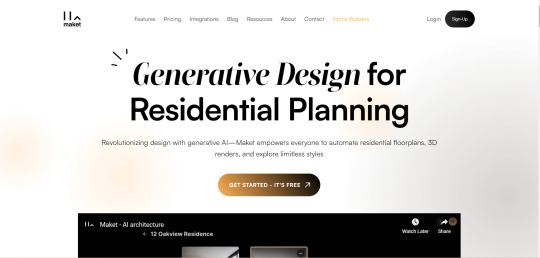
Maket AI is a powerful platform for architectural design, but knowing how to utilize its features effectively can greatly enhance your results. Here are some tips and tricks to optimize your design experience with Maket AI.
Tip 1: Clearly Define Your Project Parameters
Explanation: Before starting, specify your project requirements, such as room dimensions and adjacencies. This will help Maket AI generate more relevant design options.
Tip 2: Experiment with Different Styles
Explanation: Use the style exploration feature to visualize various design aesthetics. This can inspire creativity and help you find the perfect look for your project.
Tip 3: Leverage the Regulatory Assistant
Explanation: Don’t hesitate to ask the Regulatory Assistant about zoning codes and compliance questions. This can save you time and ensure your designs meet local regulations.
Tip 4: Utilize 3D Visualization Tools
Explanation: Take advantage of the 3D visualization features to see how your designs will look in real life. This can help you make more informed design decisions.
Tip 5: Regularly Review and Refine Your Designs
Explanation: Use Maket AI to generate multiple iterations of your designs. Regularly reviewing and refining your work can lead to improved outcomes.
Implement these tips to optimize your design process with Maket AI and create stunning architectural plans. Visit aiwikiweb.com/product/maket-ai/
#DesignTips#MaketAI#Architecture#AI#HomeDesign#UserExperience#DigitalDesign#DesignAutomation#Construction#ProjectManagement
0 notes
Video
tumblr
An AI tool that automatically maximizes your real estate inventory and counts every saleable square meter in real-time during the conceptual design stage. It’s a revolution for business developers who need precision and efficiency immediately.
#architecture#realestatedevelopment#aiinnovation#realestate#designtechnology#conceptualdesign#spaceoptimization#businessdevelopment#realtimeanalytics#designautomation#futureofdesign#innovationleaders#propertydevelopment#digitalarchitecture#AI#testFIT#artificialintelligence#realestateinvesting
0 notes
Text
AI in Graphic Design: Game-Changing Tools Every Designer Needs Now

Graphic design is always changing, and now, Artificial Intelligence (AI) is making waves. This new tech is changing how we create, opening doors we never thought possible. So, what's so special about AI in graphic design? And why should every designer use it? Let's dive into the amazing benefits AI offers. It boosts creativity and makes design work easier. AI uses machine learning and data to help designers. This leads to more inspiration, personal touches, and new ideas. It also makes sure designs work well together and improve the user experience. Quick Recommendation: Have you tried Genius.AI yet? It’s seriously a game-changer for automating online business stuff like content creation and customer engagement. It’s an AI Marketing and Social Media Manager that 100% lives up to its name. Key Takeaways - AI-powered design tools can amplify creativity and inspire new design directions - Automation and workflow optimization through AI streamline repetitive tasks and accelerate design processes - AI-assisted design enhances efficiency and productivity, enabling designers to focus on the creative aspects of their work - Personalization and brand consistency are improved with AI-driven design solutions - AI-generated visual content and branding elements can revolutionize the marketing and design landscape
Unlocking Creative Potential with AI
AI is a treasure trove of inspiration for graphic design. It uses machine learning and big data to analyze images, colors, and designs. This gives designers a lot of inspiration to spark their creativity. Amplifying Creativity and Inspiration Designers can use AI-powered platforms to find new ideas and styles. These tools show them fresh designs, artwork, and trends. Generative ai for design lets designers explore new creative paths and break traditional design rules. Facilitating Generative Art and Creativity Generative algorithms in AI can make unique and complex designs. This is known as generative art. It lets artists and designers try new things. AI image generation and AI image editing help them experiment with new techniques. This leads to more innovation and artistic expression. By using AI, designers can tap into their full creative potential. They can find new inspirations and explore what's possible in graphic design. AI brings new possibilities to the creative process. It helps designers make visually stunning and innovative content.
Streamlining Design Workflows
In the fast-changing world of graphic design, AI-powered design automation and ai-assisted graphic design tools are changing the game. They make designing easier and faster. AI helps designers focus more on being creative, making them more productive and innovative. Automating Repetitive Tasks AI in graphic design is great at doing boring tasks automatically. It can crop images, adjust colors, and remove backgrounds quickly and accurately. This lets designers spend more time on big-picture ideas and solving creative problems. It makes their work better and more efficient. Efficient Design Exploration and Iteration AI lets designers try out many different designs fast, based on what they want. This means they can quickly test ideas and improve them without starting over. It helps them try more things, make better choices, and find new solutions. AI is changing graphic design, making designers more creative and opening up new opportunities for success. https://www.youtube.com/watch?v=Ihld4D0flpE YouTube Video by Abhay Ranjan
Enhancing Design Efficiency and Productivity
In the fast-paced graphic design world, AI tools have changed how designers work. They use ai-powered design assistance and rapid prototyping and testing. These tools help designers work better and faster. AI-Powered Design Assistance AI tools look at design trends and what users like. They give designers useful tips. This helps designers make better choices and create designs that really connect with people. AI also makes it easy to turn ideas into interactive prototypes. Designers can then test these prototypes with users. This feedback helps make the final product even better. Rapid Prototyping and Testing AI has made making prototypes and testing faster. Designers can quickly create prototypes to test with users. This way, they can make changes based on feedback. This quick approach saves time and makes sure the product meets what users want. By using AI, graphic designers can do more, be more creative, and make designs that really speak to their audience. The graphic design industry is always changing. Using AI tools will be key for designers in the future.
Benefits of AI in Graphic Design
As a graphic designer, you know how much artificial intelligence (AI) can change your work. AI opens up new possibilities and takes your designs to the next level. Let's look at the amazing benefits AI brings to graphic design. Improving Personalization and User Experience AI can analyze user data to make designs that really speak to people. It makes marketing materials and user interfaces more personal. This means your designs connect better with your audience. By meeting the unique needs of your users, you create a more engaging experience. This makes your users feel valued and understood. Ensuring Brand Consistency and Cohesion Keeping a brand looking consistent across different platforms is hard. But AI can make it easier. It helps keep design elements consistent, making sure they follow your brand's rules. This keeps your brand looking professional and unified. It helps people recognize and trust your brand more. AI brings huge benefits to graphic design. It helps with personalization, improving the user experience, and keeping a strong brand image. These advantages lead to more engagement, loyalty, and success for your designs.

AI for Visual Content Creation
In the fast-changing world of graphic design, AI image generation and AI image editing are key tools for designers. These AI technologies are changing how we make, improve, and use visuals for a big impact. Tools like Stable Diffusion, DALL-E 2, and Midjourney are popular among designers. They help automate making content and give designers more time for creative work. These AI tools turn text into beautiful images, making design faster and more engaging. AI also helps with editing images through tools like Canva and MS Designer. These tools use machine learning to do tasks like retouching and color correction automatically. This saves designers time and effort, making sure designs look great on all devices. Graphic design platforms like AI Vista Studio offer even more features for making visual content better. With over 1,500 templates, users can turn ideas into eye-catching graphics. The platform also lets designers make money by offering graphic services to clients. As more designers use AI image generation and AI image editing, they see AI as a powerful creative partner. AI helps them work more efficiently, be more productive, and make content that grabs the audience's attention. Quick Recommendation: Have you tried Genius.AI yet? It’s seriously a game-changer for automating online business stuff like content creation and customer engagement. It’s an AI Marketing and Social Media Manager that 100% lives up to its name.
Empowering Accessible Design with AI
Artificial Intelligence (AI) is changing graphic design, especially in making accessible designs. AI helps designers spot and fix accessibility problems. This way, designs meet the needs of people with different abilities. AI makes designs more accessible by checking color contrast levels. WCAG (Web Content Accessibility Guidelines) sets rules for contrast. AI tools can find and fix contrast issues to help visually impaired users read and move through content easily. AI also creates alt-text for images, helping users who can't see and improving search engine rankings. Big fonts, proper line spacing, and clear interfaces make designs better for everyone. Accessibility FeatureAI ContributionColor ContrastAnalyzes and suggests improvements to meet WCAG standardsAlt-Text for ImagesAutomatically generates alternative text for visually impaired usersFont Size and Line SpacingRecommends optimal settings for enhanced readabilityUser Interface DesignCreates intuitive, easy-to-navigate interfaces AI gives designers tools to make designs more inclusive. This helps people with disabilities and makes digital content better for everyone. It makes the web more open and fun for all.

The graphic design world is changing fast. Using AI and human creativity together will make accessible design common. This partnership lets designers be more creative and reach a wider audience. It makes sure everyone can enjoy their work.
Revolutionizing Branding and Marketing Design
The use of AI in branding and marketing design is changing how businesses create their visual identities. AI helps designers make unique and impactful designs. These designs truly capture a brand's essence and connect with the audience. AI-Assisted Branding and Logo Design AI design tools have many features that make branding and logo design easier. They use machine learning to look at trends, design likes, and audience data. This creates many logo ideas that fit the brand well. Designers can then make these designs their own, ensuring they look great and are memorable. Using AI for branding and logo design has many advantages. AI can do tasks like resizing and color correction automatically, letting designers focus on being creative. It also helps with keeping a brand's look consistent across all materials by offering design elements like typography and color palettes. AI ToolKey FeaturesBenefitsAdobe Firefly- AI-powered image generation - Automated design elements - Brand color and font matching- Faster design iterations - Consistent brand identity - Reduced design costsCanva- AI-generated design templates - Automatic layout and design suggestions - Personalized design options- Time-saving design workflow - Tailored brand experiences - Accessibility for non-designersDALL-E 3 (via Bing Copilot)- AI image generation from text prompts - Ability to create unique, customized visuals - Integration with Bing search engine- Rapid prototyping and ideation - Visually engaging marketing assets - Seamless integration with existing workflows The graphic design world is changing fast, and AI is becoming more important in branding and marketing design. By using AI, designers can be more creative, efficient, and personal. This helps businesses stand out in a busy market.
Scalability and Cost-Effectiveness with AI
AI has changed the game in graphic design, making it more scalable and cost-effective. It automates repetitive tasks and makes workflows smoother. This is changing how designers and agencies work. AI helps graphic design scale up without losing quality. It lets designers and agencies take on more projects. This is great for startups and small businesses. They can get professional design services without a big team. AI also makes graphic design more cost-effective. It automates tasks like image editing and resizing. This cuts down the time and resources needed, lowering costs for design agencies. They can then offer high-quality services at lower prices. AI makes managing projects more efficient too. It gives real-time feedback and helps with design changes. This saves time and reduces the need for costly revisions, making AI in graphic design more cost-effective. Investing in AI-driven design tools might seem costly at first. But the long-term benefits of scalability and cost savings are huge. With the AI market growing fast, using these technologies in graphic design is set to become more common and important. In conclusion, AI brings scalability and cost savings to graphic design. It helps designers and agencies work more efficiently and affordably. As the industry changes, using AI tools can be a big advantage for businesses looking to succeed in graphic design. Quick Recommendation: Have you tried Genius.AI yet? It’s seriously a game-changer for automating online business stuff like content creation and customer engagement. It’s an AI Marketing and Social Media Manager that 100% lives up to its name.
Conclusion: Embracing AI as a Creative Partner
AI has changed the graphic design world in big ways. It's changed how designers think, make, and finish their work. By using AI, you can unlock your creative side, make your work easier, and create designs that speak to today's audience. The future of graphic design is all about AI's growth and new ideas. By working with AI, you can take your design to new heights. Most designers see the value in using AI for new ideas and making their work better. But, it's important to keep your human touch and artistic side strong. AI is a great tool, but it should work with your unique vision. By working together with AI, you can explore new ideas, try new things, and achieve top-notch design.

#image_title
FAQ
What are the benefits of using AI in graphic design? AI helps graphic designers in many ways. It unlocks creativity, makes work easier, and boosts efficiency. It also makes designs more personal and consistent, and it's cost-effective. How can AI help designers unlock their creative potential? AI gives designers lots of inspiration by looking at visual data. It shows them design trends and patterns. Plus, AI can make unique designs, helping designers try new things. How does AI streamline design workflows? AI tools automate tasks like cropping images and adjusting colors. This lets designers focus on being creative and making big decisions. AI also helps by making many design options quickly. How does AI enhance design efficiency and productivity? AI helps by analyzing data and trends to give designers good advice. It makes making prototypes fast, leading to better products. This makes the design process smoother and more focused. What are the benefits of AI in improving personalization and brand consistency? AI makes designs more personal by using user data. It also keeps designs consistent across different places, making a brand look professional. How can AI assist with visual content creation and image editing? AI tools can make unique visuals and help with editing images. This saves time and makes the design process more efficient. How does AI empower accessible design? AI finds ways to make designs better for everyone, like making colors clear for the visually impaired. This makes design more inclusive. How can AI revolutionize branding and marketing design? AI can make logos that fit a brand's style and appeal to its audience. It also offers templates for professional-looking branding. How does AI contribute to the scalability and cost-effectiveness of graphic design? AI automates tasks and boosts efficiency, cutting costs. This lets design agencies take on more projects without sacrificing quality, helping the business grow. Read the full article
#AIinGraphicDesign#ArtificialIntelligenceBenefits#DesignAutomation#DigitalCreativity#GraphicDesignTools
0 notes
Text
Tired of Repetitive Design Tasks?

Say goodbye to manual edits and hello to efficiency with Adobe Illustrator's Variable feature!
This powerful tool allows you to create countless variations of your designs in just a few clicks. Perfect for personalized projects, mass customization, and more.
📌 What you'll learn:
✅ How to set up and use Illustrator's Variable feature
✅ Tips and tricks for maximizing efficiency
✅ Real-world examples of automated design workflows
✨ Why it matters:
✅ Save time and reduce errors
✅ Increase your productivity and creativity
✅ Deliver customized designs with ease
🚀 Start automating your designs today!
Check out the full blog post and unleash your creative potential.
Follow -
LinkedIn-Skillivo
Read Article- Illustrator’s Variable Helps You to Automate 100s of Unique Designs
#DesignAutomation#AdobeIllustrator#GraphicDesign#CreativeTools#DesignTips#Efficiency#DigitalArt#Automation#skillivo#IllustratorTips
1 note
·
View note
Text
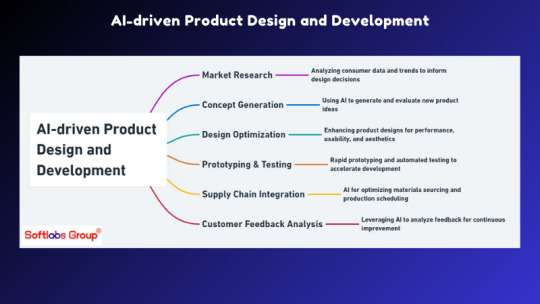
Delve into the realm of AI-driven product design and development with our comprehensive exploration. Discover how artificial intelligence revolutionizes the design process by generating innovative concepts, optimizing designs, and simulating performance. From generative design algorithms to predictive analytics, grasp how AI streamlines the development lifecycle, accelerates time-to-market, and enhances product quality. Whether you're a product designer or a development engineer, our guide simplifies the integration of AI technologies to drive innovation and competitiveness. Stay ahead of the curve with Softlabs Group for the latest advancements in AI-driven solutions transforming product design and development.
0 notes
Text

Need to automate your custom design process? ⚙️🖥️ With DriveWorks support from Design & Automation Services, you can deliver tailored designs faster, smarter, and with total accuracy.
Let’s streamline your workflow today! Call us on 📞 +91 9574 024 279 or Visit: https://www.designautomations.com/
0 notes
Text
Meeting the Needs of Specifiers: Key Considerations for BIM Object Development
#bimservices#bimobject#3d cad modeling#3d model#construction#designautomation#engineeringservices#fabrication#3d bim modeling services#steeldetailingservices#shopdrawingservices
0 notes
Text
PRODUCT DESIGN IN 2023-24
Product design in 2023-24: Introduction Product design is the process of creating new products or improving existing ones. It is a multidisciplinary field that combines art, science, and technology to develop products that meet the needs and desires of consumers while also being functional, aesthetically pleasing, and cost-effective to manufacture. Effective product design is crucial for the success of a product, as it can influence consumer behavior, brand image, and profitability. In this article, we will explore the different aspects of product design, including the design process, design principles, and design thinking. The Product Design Process Future of product design trend in TOP PRODUCT DESIGN EXPORTER COUNTRIES PRODUCT DESIGN IMPORTER COUNTRIES TOP 25 PRODUCT DESIGN COMPANIES IN WORLD TOP DIGITAL PRODUCT DESIGN COMPANIES
The Product Design Process
The product design process is a systematic approach to creating new products or improving existing ones. It involves a series of steps that include research, ideation, prototyping, testing, and production. The design process can be divided into six stages: - Research: The first stage of the design process is research. This involves understanding the market, target customers, and competition. Research can help designers identify opportunities and challenges, as well as gather insights that can inform the design of the product. Some common research methods include surveys, focus groups, and market analysis. - Ideation: The second stage of the design process is ideation. This involves generating ideas and concepts for the product. Designers often use brainstorming and sketching to generate ideas. They then select the most promising ideas and develop them further through computer-aided design (CAD) and 3D modeling, which allows them to visualize the product in detail and make necessary modifications. - Prototyping: The third stage of the design process is prototyping. This involves creating a prototype or a series of prototypes, which are tested and refined through user feedback and further iterations. Prototyping can help designers identify and address any issues or flaws in the product and ensure that it meets the needs of the target audience. - Testing: The fourth stage of the design process is testing. This involves testing the product with actual users to gather feedback and identify any usability issues. Testing can help designers refine the product and ensure that it meets the needs of the target audience. - Production: The fifth stage of the design process is production. This involves preparing the product for production, which involves selecting materials, creating manufacturing specifications, and ensuring that the product can be produced at scale while maintaining quality and cost-effectiveness. - Launch: The final stage of the design process is launch. This involves launching the product and promoting it to the target audience. Launch can involve various marketing strategies, such as advertising, public relations, and social media. Design Principles Design principles are a set of guidelines that designers use to create effective products. There are several design principles that designers use, including: - Functionality: Products should be functional and meet the needs of the user. This means that the product should be easy to use, efficient, and reliable. - Aesthetics: Products should be aesthetically pleasing and visually appealing. This means that the product should be visually attractive and have a cohesive design. - Usability: Products should be easy to use and intuitive. This means that the product should be easy to understand and use, and should not require a lot of training or instruction. - Accessibility: Products should be accessible to a wide range of users. This means that the product should be designed to accommodate users with different abilities and needs. - Sustainability: Products should be sustainable and environmentally friendly. This means that the product should be designed with sustainability in mind, such as using eco-friendly materials and reducing waste. Design Thinking Design thinking is a problem-solving approach that involves empathy, ideation, prototyping, and testing. It is a human-centered approach that emphasizes understanding the needs and desires of the user. Design thinking is often used in product design to create products that meet the needs.
Future of product design trend in
Product design in 2023-24 is likely to continue to evolve in response to changing technology, societal trends, and environmental concerns. Some of the key trends and developments that are likely to shape product design in the coming years include: - Sustainable design: More and more consumers are becoming aware of the impact of their purchases on the environment, and as a result, sustainable design is likely to become even more important in the years ahead. Designers will increasingly focus on creating products that are made from environmentally friendly materials, that can be easily recycled or repurposed, and that minimize waste. - User-centric design: In recent years, there has been a growing emphasis on user-centric design, which involves designing products that are tailored to the needs and preferences of individual users. In the years ahead, designers will continue to focus on creating products that are intuitive, easy to use, and provide a personalized experience for each user. - Augmented reality: Augmented reality technology is likely to play an increasingly important role in product design in the coming years. Designers will be able to use AR technology to create immersive, interactive product experiences that allow consumers to visualize products in their own homes before making a purchase. - Voice and gesture controls: As voice and gesture control technology continues to improve, it is likely that designers will increasingly incorporate these features into their products. This will allow users to interact with products in new and innovative ways, without the need for physical buttons or touchscreens. - Artificial intelligence: Artificial intelligence is already being used in product design in a variety of ways, from predictive analytics to virtual product testing. In the coming years, designers will continue to explore the potential of AI to help them create more efficient, effective, and user-friendly products. Overall, the future of product design in 2023-24 looks to be exciting and dynamic, as designers continue to push the boundaries of what is possible with technology and materials, while also keeping the needs and desires of consumers in mind.
TOP PRODUCT DESIGN EXPORTER COUNTRIES
Here are the top product design exporter countries in the world: - China - China is the world's largest exporter of products, including product designs, with an estimated value of $2.5 trillion in 2020. - United States - The US is the second-largest exporter of products and also has a thriving product design industry. The US exported approximately $1.4 trillion in products in 2020. - Germany - Germany is a major exporter of high-quality industrial products, including product designs, with an estimated export value of $1.2 trillion in 2020. - Japan - Japan is a leading exporter of electronic and automotive products, including product designs, with an estimated export value of $698 billion in 2020. - South Korea - South Korea is a major exporter of electronic and automotive products, and also has a growing product design industry. The country exported approximately $542 billion in products in 2020. - Netherlands - The Netherlands is a major exporter of high-tech and innovative products, including product designs, with an estimated export value of $523 billion in 2020. - France - France has a diverse product design industry, ranging from luxury goods to industrial products, and exported an estimated $487 billion in products in 2020. Italy - Italy is known for its design excellence, particularly in the fashion and luxury goods industry. The country exported approximately $456 billion in products in 2020. - United Kingdom - The UK is a major exporter of aerospace, defense, and industrial products, including product designs, with an estimated export value of $422 billion in 2020. - Belgium - Belgium has a strong product design industry and is a major exporter of high-tech products. The country exported approximately $404 billion in products in 2020. These rankings may vary from year to year based on various factors such as economic conditions, global trade policies, and market demand.

PRODUCT DESIGN IMPORTER COUNTRIES
Product design is an essential aspect of the manufacturing industry, and many countries rely on importing products designed by other nations. The top product design importer countries are: - United States: The United States is one of the largest importers of products designed in other countries, with a focus on technology, fashion, and home goods. - Germany: Germany is known for its high standards in product design, and the country is a major importer of industrial and mechanical products. - Japan: Japan is a leader in innovative product design, and the country is a significant importer of electronic and automotive products. - United Kingdom: The United Kingdom is a major importer of fashion and home goods products designed by other nations. - France: France is renowned for its fashion and luxury product design, and the country is a significant importer of these types of products. - Canada: Canada is a major importer of technology products designed by other nations, with a focus on software and hardware products. - Australia: Australia is a significant importer of consumer electronics and automotive products designed by other nations. - Netherlands: The Netherlands is a major importer of industrial and mechanical products designed by other nations. - Italy: Italy is known for its high-quality fashion and luxury products, and the country is a significant importer of these types of products. - South Korea: South Korea is a leader in technological innovation and is a significant importer of electronic and software products designed by other nations.

TOP 25 PRODUCT DESIGN COMPANIES IN WORLD
The top 25 product design and manufacturing companies in the world: - Apple - Apple is a technology company that designs and manufactures a range of consumer electronics and software products, including the iPhone, iPad, and Mac computers. - Samsung - Samsung is a multinational conglomerate that produces a range of electronic products, including smartphones, televisions, and home appliances. - Google - Google is a technology company that specializes in internet-related products and services, such as search engines, online advertising, and software. - Amazon - Amazon is a multinational technology company that is primarily known for its e-commerce platform, but also produces consumer electronics and offers cloud computing services. - Microsoft - Microsoft is a technology company that produces a range of software and hardware products, including the Windows operating system, Surface tablets, and Xbox gaming consoles. - Sony - Sony is a multinational conglomerate that produces a range of electronic products, including televisions, audio equipment, and gaming consoles. - LG - LG is a multinational electronics company that produces a range of products, including smartphones, televisions, and home appliances. - Huawei - Huawei is a multinational technology company that produces a range of consumer electronics and telecommunications equipment. - Tesla - Tesla is an American electric vehicle and clean energy company that designs and manufactures electric cars, energy storage systems, and solar products. - IBM - IBM is a multinational technology company that produces a range of software and hardware products, including the Watson AI platform and mainframe computers. - HP Inc. - HP Inc. is a multinational technology company that produces a range of personal computers, printers, and related products. - Dell Technologies - Dell is a technology company that produces a range of personal computers, servers, and related products. - Intel - Intel is a technology company that produces a range of microprocessors and related products for the computer industry. - Cisco - Cisco is a multinational technology company that produces networking equipment and related products for the telecommunications industry. - GE - GE is a multinational conglomerate that produces a range of products, including aircraft engines, power generation equipment, and medical equipment. - 3M - 3M is a multinational technology company that produces a range of products, including adhesives, abrasives, and films. - Siemens - Siemens is a multinational conglomerate that produces a range of products, including power generation equipment, medical equipment, and industrial automation systems. - Boeing - Boeing is an American aerospace company that designs and manufactures commercial and military aircraft, satellites, and related products. - Airbus - Airbus is a European aerospace company that designs and manufactures commercial aircraft, military transport planes, and related products. - Lockheed Martin - Lockheed Martin is an American aerospace and defense company that designs and manufactures military aircraft, missiles, and related products. - General Motors - General Motors is an American multinational automotive company that designs and manufactures a range of vehicles, including cars, trucks, and SUVs. - Ford - Ford is an American multinational automotive company that designs and manufactures a range of vehicles, including cars, trucks, and SUVs. - Toyota - Toyota is a Japanese multinational automotive company that designs and manufactures a range of vehicles, including cars, trucks, and SUVs. - Honda - Honda is a Japanese multinational automotive company that designs and manufactures a range of vehicles, including cars, motorcycles, and power equipment - BMW - BMW is a German multinational automotive company that designs and manufactures a range of vehicles, including cars and motorcycles.
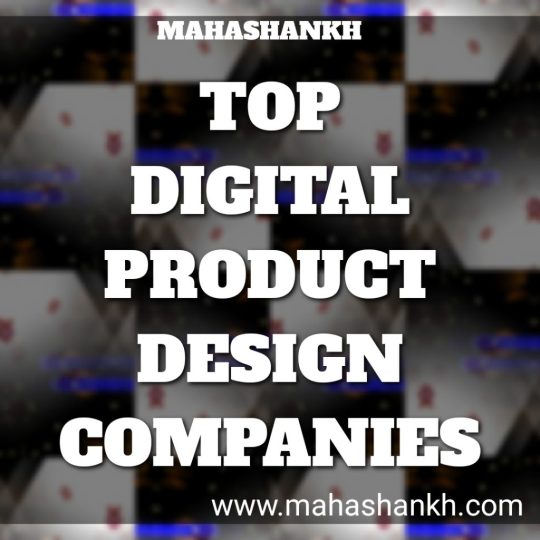
TOP DIGITAL PRODUCT DESIGN COMPANIES
20 top digital product design companies: - IDEO: IDEO is a global design firm that specializes in product design, user research, and user experience (UX) design. They have worked with companies like Apple, Procter & Gamble, and Airbnb. - Frog Design: Frog Design is a global design firm that specializes in product design, user research, and UX design. They have worked with companies like Microsoft, GE, and Disney. - Pentagram: Pentagram is a design firm with offices in London, New York, San Francisco, and Berlin. They specialize in branding, product design, and UX design. They have worked with companies like Verizon, Citibank, and Mastercard. - Fjord: Fjord is a global design and innovation consultancy that specializes in product design, UX design, and service design. They have worked with companies like Google, Samsung, and BMW. - ustwo: ustwo is a digital product studio that specializes in product design, UX design, and development. They have worked with companies like Google, Nike, and Ford. - Huge: Huge is a digital agency that specializes in product design, UX design, and development. They have worked with companies like IKEA, PepsiCo, and Google. - R/GA: R/GA is a global digital agency that specializes in product design, UX design, and development. They have worked with companies like Nike, Verizon, and Samsung. - Smart Design: Smart Design is a design and innovation consultancy that specializes in product design, UX design, and branding. They have worked with companies like Ford, PepsiCo, and HP. - AKQA: AKQA is a digital agency that specializes in product design, UX design, and development. They have worked with companies like Nike, Airbnb, and Google. Read the full article
#3m#AMAZON#APPLE#BN#CHAINA#Cisco#ConceptDesign#CreativeDesign#DELL#DesignAccessibility#DesignAdvertising#DesignAesthetics#DesignAgency#DesignAnalysis#DesignArtisanship#DesignArtistry#DesignAutomation#DesignBrandExperience#DesignBrandGuidelines#DesignBrandIdentity#DesignBrandPositioning#DesignBrandRecognition#DesignBrandStrategy#DesignBusinessStrategy#DesignClientEngagement#DesignClientPartnership#DesignClientSatisfaction#DesignCollaboration#DesignCollateral#DesignCommunication
0 notes
Text
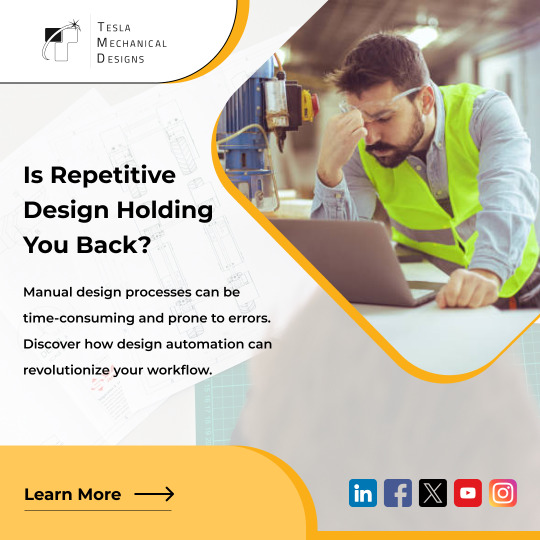
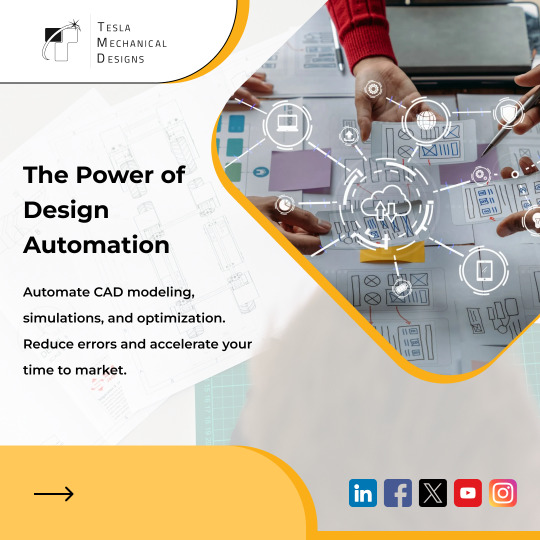
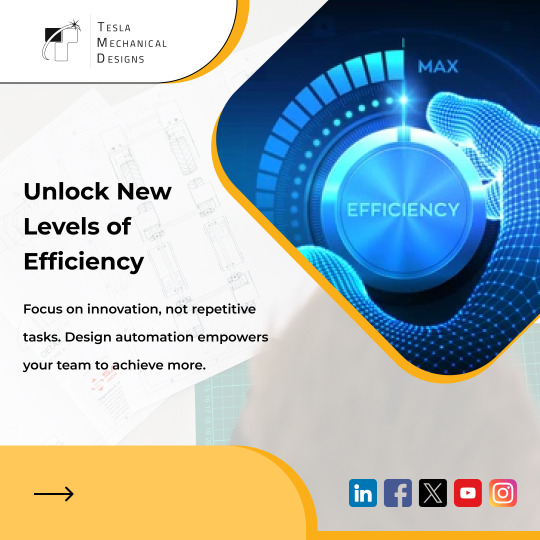
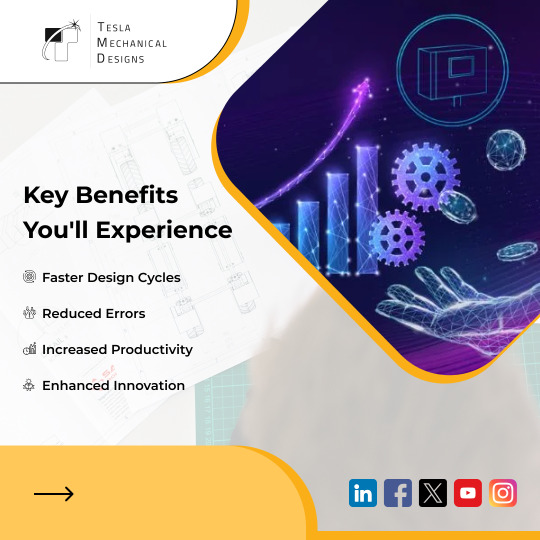
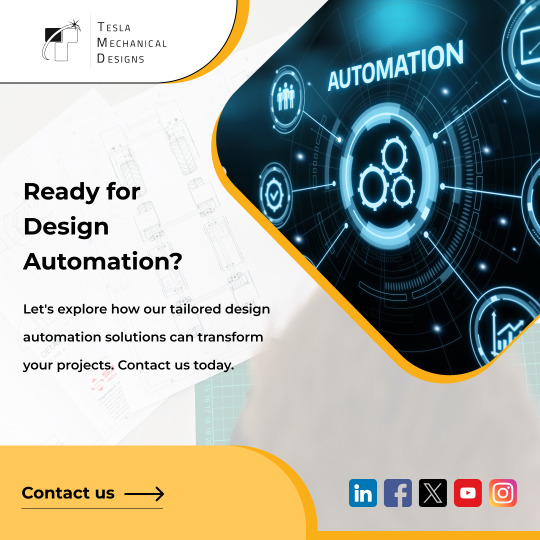
🔧 Struggling with repetitive design tasks? It might be time to rethink your workflow. 🛠️ What if you could speed up your design process without sacrificing quality? At Tesla Mechanical Designs, we specialize in cutting-edge design automation solutions that streamline your CAD modeling, simulations, and optimization, reducing errors and accelerating your time to market. Curious how automation can revolutionize your workflow? Tap through to see how our tailored solutions can take your design process to the next level! 🚀
0 notes